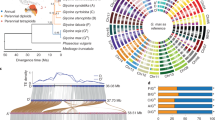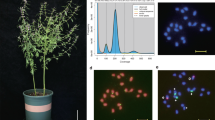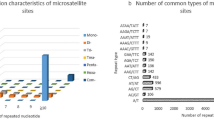Abstract
Levels of allozyme variation are compared between a diploid invasive plant species, Lonicera japonica Thunb. (2n = 18) and its polyploid native congener, Lonicera sempervirens L. (2n = 36). Both are woody perennials and were sampled within the native range of L. sempervirens in the south-eastern United States where L. japonica has been an invader since the late 19th century. Genetic structure and allozyme diversity were determined for nine and ten populations of L. sempervirens and L. japonica, respectively. Genetic variation within L. japonica is similar to that in other species with similar life history traits (per cent polymorphic loci, Ps = 75 per cent, mean alleles per polymorphic locus, Aps = 2.28, and total genetic diversity, Ht = 0.216); L. sempervirens has even higher genetic variation than L. japonica (Ps = 91 per cent, Aps = 2.60 and Ht = 0.283). Although both species have high levels of genetic diversity, this may be less important than their life history traits to their success in early successful habitats. However, establishment of a relationship between success in naturalization for woody perennials and levels of genetic diversity is hampered by the paucity of comparable records for other native: alien congeneric pairs.
Similar content being viewed by others
Article PDF
References
Adams, W T, and Joly, R J. 1980. Genetics of allozyme variants in loblolly pine. J Hered, 71, 33–40.
Ammal, E K J, and Saunders, B. 1952. Chromosome numbers in species of Lonicera. Kew Bull, 4, 539–541.
Baker, H G. 1965. Characteristics and modes of origin of weeds. In: Baker, H. G. and Stebbins, G. L. (eds) The Genetics of Colonizing Species, pp. 147–172. Academic Press, New York.
Baker, H G. 1974. The evolution of weeds. Ann Rev Ecol Syst, 5, 1–24.
Baker, H G. 1986. Patterns of plant invasion in North America. In: Mooney, H. A. and Drake, J. A. (eds) Ecology of Biological Invasions of North America and Hawaii, pp. 44–57. Springer Verlag, New York.
Barrett, S C H, and Richardson, B J. 1986. Genetic attributes of invading species. In: Groves, R. H. and Burdon, J. J. (eds) Ecology of Biological Invasions, pp. 21–33. Cambridge University Press, Melbourne, Australia.
Barrett, S C H, and Shore, J S. 1989. Isozyme variation in colonizing plants. In: Soltis, D. E. and Soltis, P. S. (eds) Isozymes in Plant Biology, pp. 106–126. Dioscorides Press, Portland, OR.
Brown, A H D, and Marshall, D R. 1981. Evolutionary changes accompanying colonization in plants. In: Scudder, G. C. E. and Reveal, J. L. (eds) Colonization, Succession and Stability, pp. 351–363. Blackwell Scientific Publications, Oxford.
Brown, A H D, Matheson, A C, and Eldridge, K G. 1975. Estimation of the mating system of Eucalyptus obliqua L'Heret by using enzyme polymorphisms. Aust J Bot, 23, 931–949.
Godt, M J W, and Hamrick, J L. 1991. Genetic variation in Lathyrus latifolius (Leguminosae). Am J Bot, 78, 1163–1171.
Gottlieb, L D. 1981. Gene numbers in species of Asteraceae that have different chromosome numbers. Proc Natl Acad Sci USA, 78, 3726–3729.
Gray, A J. 1986. Do invading species have definable genetic characteristics? Phil Trans R Soc B, 314, 655–674
Hamrick, J L, and Godt, M J W. 1989. Allozyme diversity in plant species. In: Brown, A. H. D., Clegg, M. T., Kahler, A. L. and Weir, B. S. (eds) Plant Population Genetics, Breeding and Genetic Resources, pp. 43–63. Sinauer, Sunderland, MA.
Hamrick, J L, Godt, M J W, and Sherman-Broyles, S L. 1992. Factors influencing levels of genetic diversity in woody plant species. New Forests, 6, 95–124.
Hamrick, J L, Linhart, Y B, and Mitton, J B. 1979. Relationships between life history characteristics and electrophoretically detectable genetic variation in plants. Ann Rev Ecol Syst, 10, 173–200.
Handel, S N. 1983. Pollination ecology, plant population structure and gene flow. In: Real, L. A. (ed) Pollination Biology, pp. 163–211. Academic Press, New York.
Hedrick, P W. 1985. Genetics of Populations. Jones and Bartlett, Boston.
Johnsgard, P A. 1983. The Hummingbirds of North America. Smithsonian Institution Press, Washington, DC.
Leatherman, A D. 1955. Ecological Life-history of Lonicera japonica Thunb. Ph.D. Thesis, University of Tennessee, Knoxville, TN.
Li, C C, and Horvitz, D G. 1953. Some methods of estimating the inbreeding coefficient. Am J Hum Genet, 5, 107–117.
Loveless, M D, and Hamrick, J L. 1984. Ecological determinants of genetic structure in plant populations. Ann Rev Ecol Syst, 15, 65–95.
Mack, R N. 1985. Invading plants: their potential contribution to population biology. In: White, J. (ed.) Studies on Plant Demography: J. L. Harper Festschrift, pp. 127–142. Academic Press, London.
Mack, R N. 1991. The commercial seed trade: an early disperser of weeds in the United States. Econ Bot, 45, 257–273.
Mitton, J B, Linhart, Y B, Hamrick, J L, and Beckman, J S. 1977. Observations on the genetic structure and mating system of ponderosa pine in the Colorado front range. Theor Appl Genet, 51, 5–13.
Moore, N J, and Moran, G F. 1989. Microgeographic patterns of allozyme variation in Casuarina cunninghamiana within and between the Murrumbidge and coastal drainage systems. Aust J Bot, 37, 181–192.
Moran, G F, Bell, J C, and Turnbull, J W. 1989a. A cline in genetic diversity in River she-oak (Casuarina cunninghamiana). Aust J Bot, 37, 169–180.
Moran, G F, Muona, O, and Bell, J C. 1989b. Breeding systems and genetic diversity in Acacia auriculiformis and A. crassicarpa. Biotropica, 21, 250–256.
Nel, M. 1973. Analysis of gene diversity in subdivided populations. Proc Natl Acad Sci USA, 70, 3321–3323.
Nei, M. 1977. F-statistics and analysis of gene diversity in subdivided populations. Ann Hum Genet, 41, 225–233.
Nei, M. 1978. Estimation of average heterozygosity and genetic distance from a small number of individuals. Genetics, 89, 583–590.
Oosting, H J. 1942. An ecological analysis of the plant communities of the Piedmont, North Carolina. Am Midi Nat, 28, 1–126.
Paneida, F D, and Carstairs, S A. 1989. Isozymic discrimination of tropical Australian populations of mesquite (Prosopis spp.); implication for biological control. Weed Res, 29, 157–165.
Radford, A E, Ahles, H E, and Bell, C R. 1968. Manual of the Vascular Flora of the Carolinas. The University of North Carolina Press, Chapel Hill.
Roose, M L, and Gottlieb, L D. 1976. Genetic and biochemical consequences of polyploidy in Tragopogon. Evolution, 30, 818–830.
Sasek, T W. 1983. Growth and Biomass Allocation Patterns of Lonicera japonica Thunb. and Lonicera sempervirens L. under Carbon Dioxide Enrichment. M.S. Thesis, Duke University, Durham, NC.
Sasek, T W, and Strain, B R. 1991. Effects of C02 enrichment on the growth, and morphology of a native and an introduced honeysuckle vine. Am J Bot, 78, 69–75.
Sax, K, and Kribs, D A. 1930. Chromosomes and phylogeny in Caprifoliaceae. J Arnold Arbort, 11, 147–153.
Schierenbeck, K A. 1992. Comparative Ecological and Genetic Studies Between a Native (Lonicera sempervirens L.) and an introduced vine (L. japonica Thunb.). Ph.D. Thesis, Washington State University, Pullman, WA.
Shaw, C R, and Prasad, R. 1970. Starch gel electrophoresis of enzymes - a comparison of recipes. Biochem Genet, 4, 297–320.
Slezak, W F. 1976. Lonicera japonica Thunb., an Aggressive Introduced Species in a Mature Forest Ecosystem. M.S. Thesis, Rutgers University, New Brunswick, NJ.
Snow, B, and Snow, D. 1988. Birds and Berries, A Study of an Ecological Interaction. T. and A. D. Poyser, Calton, U.K.
Soltis, D E, Haufler, C H, Darrow, D C, and Gastony, G J. 1983. Starch gel electrophoresis of ferns: a compilation of grinding buffers, gel and electrode buffers, and staining schedules. Am Fern J, 73, 9–27.
Stebbins, G L. 1971. Chromosomal Evolution in Higher Plants. Edward Arnold, London.
Surles, S C, Hamrick, J L, and Bongarten, B C. 1989. Allozyme variation in black locust (Robinia pseudoacacia). Can J Forest Res, 19, 471–479.
Vitousek, P. 1986. Biological invasions and ecosystem properties: can species make a difference. In: Mooney, H. A. and Drake, J. A. Drake (eds) Ecology of Biological Invasions of North America and Hawaii, pp. 163–176. Springer-Verlag, New York.
Waddington, K D. 1983. Foraging behavior of pollinators. In: Real, L. A. (ed.) Pollination Biology, pp. 213–239. Academic Press, New York.
Warwick, S I. 1990. Allozyme and life-history variation in five northwardly colonizing North American weed species. Pl SystEvol, 169, 41–54.
Weeden, N F, and Wendel, J F. 1989. Genetics of plant isozymes. In: Soltis, D. E. and Soltis, P. S. (eds) Isozymes in Plant Biology, pp. 46–72. Dioscorides Press, Portland, OR.
Workman, P L, and Niswander, J D. 1970. Population studies on southwestern Indian tribes. II. Local genetic differentiation in the Pagayo. Am J Hum Genet, 22, 24–49.
Wright, S. 1922. Coefficients of inbreeding and relationship. Am Nat, 56, 330–338.
Acknowledgements
This research was supported under Contract No. DE-AC09-76SROO-819 between the U.S. Department of Energy and the University of Georgia, NSF doctoral dissertation improvement grant BSR-8914717 to K.A.S. and R.N.M., Sigma Xi, the Hardman Foundation and The Nature Conservancy. The authors thank M. Rodgers and J. W. Eckert for help with collecting plant samples, D. E. and R S. Soltis for the use of their laboratory during preliminary data collection, S. Sher-man-Broyles, E. Berg, J. Tyrell, L. Manning and S. Dil-lard for laboratory assistance, M. D. Loveless and A. Schnabel for the use of the computer program for data analysis, and D. E. Soltis, A. Schnabel and S. Warwick for comments on the manuscript.
Author information
Authors and Affiliations
Rights and permissions
About this article
Cite this article
Schierenbeck, K., Hamrick, J. & Mack, R. Comparison of allozyme variability in a native and an introduced species of Lonicera. Heredity 75, 1–9 (1995). https://doi.org/10.1038/hdy.1995.97
Received:
Issue date:
DOI: https://doi.org/10.1038/hdy.1995.97
Keywords
This article is cited by
-
Single nucleotide polymorphisms for assessing genetic diversity in castor bean (Ricinus communis)
BMC Plant Biology (2010)
-
Classical biological control: exploiting enemy escape to manage plant invasions
Biological Invasions (2008)



